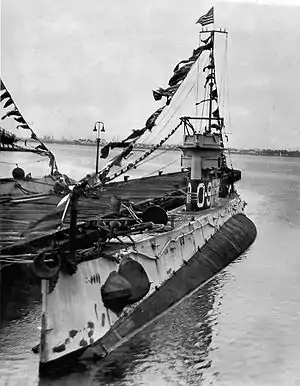USS O-9 (SS-70)
USS O-9 (SS-70) was an O-class submarine of the United States Navy. Her keel was laid down on 15 February 1917 at Fore River Shipbuilding Company of Quincy, Massachusetts. She was launched on 27 January 1918 sponsored by Mrs. Frederick J. Sherman, and commissioned on 27 July 1918 with Lieutenant Oliver M. Read, Jr. in command.
 | |
| History | |
|---|---|
| Name: | USS O-9 |
| Ordered: | 3 March 1916 |
| Builder: | Fore River Shipbuilding Company, Quincy, Massachusetts |
| Laid down: | 15 February 1917 |
| Launched: | 27 January 1918 |
| Commissioned: | 27 July 1918 |
| Decommissioned: | 25 June 1931 |
| Recommissioned: | 14 April 1941 |
| Stricken: | 23 October 1941 |
| Fate: | Foundered, 20 June 1941 |
| General characteristics | |
| Type: | O-class submarine |
| Displacement: |
|
| Length: | 172 ft 4 in (52.53 m) |
| Beam: | 18 ft (5.5 m) |
| Draft: | 14 ft 5 in (4.39 m) |
| Installed power: | |
| Propulsion: |
|
| Speed: |
|
| Complement: | 2 officers, 27 men |
| Armament: |
|
Service history
During the final months of World War I, O-9 operated on coastal patrol and protected the Atlantic coast from U-boats. She departed Newport, Rhode Island, on 2 November 1918 for Britain, in order to conduct her first war patrol. However, the end of the war came before O-9 reached Europe.
After the war, O-9 continued in Naval service and trained submarine crews at the Submarine School at New London, Connecticut. Proceeding to Coco Solo, Panama Canal Zone, in 1924, the boat was reclassified to a second line submarine during her year there. Returning to operate at New London, O-9 reverted to a first line submarine on 6 June 1928. Sailing up to Portsmouth, New Hampshire in January 1930, the submarine returned to New London in March; the following February, she sailed to Philadelphia, Pennsylvania, to decommission there on 25 June 1931.
Remaining on the Naval Vessel Register, O-9 was recalled to training service as American involvement in World War II became more inevitable. The 12 Tambor-class submarines were already nearing completion and 73 Gato class boats had already been ordered when O-9 was recommissioned at Philadelphia, on 14 April 1941, and went to New London on 31 May.
In all, eight of the original ten O-boats were recommissioned to serve as training submarines in the Second World War. (The O-5 had been sunk after a collision in 1923 and the O-1 had been scrapped in 1938.) O-9, in particular, required extensive work, and still suffered mechanical problems even after being returned to service.
On the morning of 19 June 1941, O-9 and two of her sisters, O-6 and O-10, left as a group from the submarine base in New London, for the submarine test depth diving area east of the Isles of Shoals. Upon reaching their designated training area the following day, some 15 mi (24 km) off Portsmouth, New Hampshire, O-6 made the first dive, followed by O-10. Finally, at 08:37, O-9 began her dive. At 10:32, O-9 had not returned to the surface.
Rescue ships swung into action immediately. Sister ships O-6 and O-10, submarine Triton, submarine rescue ship Falcon, and other ships searched for O-9. That evening, pieces of debris with markings from O-9 were recovered. In water 450 ft (140 m) deep, she was thought to be crushed, since her hull was only designed to withstand depths of 212 ft (65 m).[1]
Divers went down from 13:00 on 21 June until 11:43 on 22 June. Divers could stay only a short time at the 440 ft (130 m) depth but nonetheless set endurance and depth records for salvage operations until those operations were cancelled, as they were considered too risky. Rescue operations were discontinued on 22 June. The boat and her 33 officers and men were declared lost as of 20 June. On 22 June, Secretary of the Navy Frank Knox conducted memorial services for the 33 officers and men lost on the boat.
Wreck

On 20 September 1997, based on several years of research by Glen M. Reem (USNR Retired) the O-9 was finally located. Salem, New Hampshire-based Klein Sonar Company provided a vessel and sonar equipment which were used to discover O-9's final resting place. Her hull has been crushed from just abaft the conning tower all the way to the stern, though the forward hull appeared intact. There are no plans to salvage O-9. Her exact location is secret and the area has been designated an official Naval burial ground.
O-9 was struck from the Naval Vessel Register on 23 October 1941.
Gallery
 Front side of gate pass from USS O-9 (SS-70) circa 1930 which once belonged to crewman Joseph Collier Faulk.
Front side of gate pass from USS O-9 (SS-70) circa 1930 which once belonged to crewman Joseph Collier Faulk. Back side of the same gate pass.
Back side of the same gate pass. Three-day pass from USS O-9 (SS-70) dated 26 May 1930 used by Joseph Collier Faulk.
Three-day pass from USS O-9 (SS-70) dated 26 May 1930 used by Joseph Collier Faulk.
References
- This article incorporates text from the public domain Dictionary of American Naval Fighting Ships. The entry can be found here.
- "Submarine Casualties Booklet". U.S. Naval Submarine School. 1966. Retrieved 2009-09-08. Cite journal requires
|journal=(help)